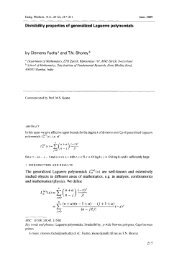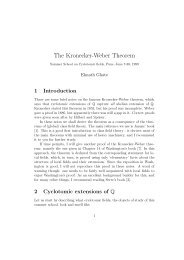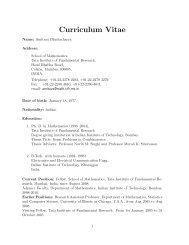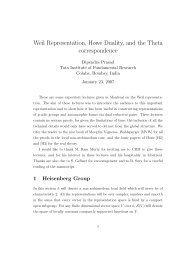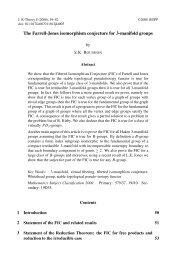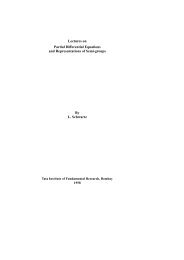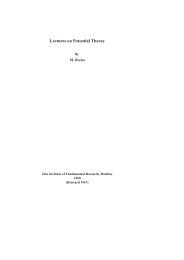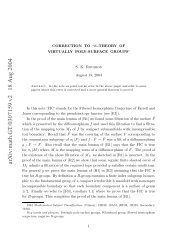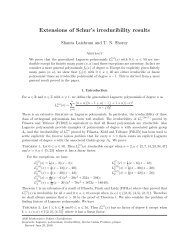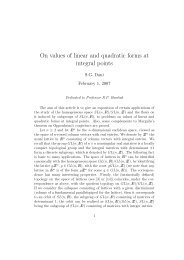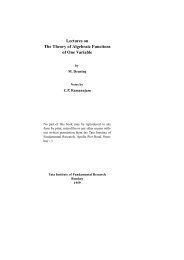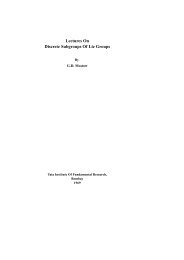Lectures on the Algebraic Theory of Fields - Tata Institute of ...
Lectures on the Algebraic Theory of Fields - Tata Institute of ...
Lectures on the Algebraic Theory of Fields - Tata Institute of ...
- No tags were found...
You also want an ePaper? Increase the reach of your titles
YUMPU automatically turns print PDFs into web optimized ePapers that Google loves.
4. <strong>Algebraic</strong> Closure 11¯σx=σ α xwhere x∈K α . (Note that every x∈K is in some K α in <strong>the</strong> simplyordered subfamily). It is easy to see that ¯σ is well - defined. Supposex∈K β and K β ⊂ K α <strong>the</strong>nσ α is an extensi<strong>on</strong> <strong>of</strong>σ ρ and soσ α x=σ β x.This proves that ¯σ is an isomorphism <strong>of</strong> K <strong>on</strong> K ′ and extendsσ. Thus<strong>the</strong> triplet (K, K ′ , ¯σ) is in M and is an upper bound <strong>of</strong> <strong>the</strong> subfamily.By Zorn’s lemma <strong>the</strong>re exists a maximal triplet (Ω,Ω ′ ,τ). We assertthatΩis algebraically closed; for if not letρbe a root <strong>of</strong> an irreduciblepolynomial f (x)∈Ω[x]. Then f ζ (x)∈Ω ′ [x] is also irreducible. Letρ ′be a root <strong>of</strong> f τ (x). Thenτcan be extended to an isomorphism ¯τ <strong>of</strong>Ω(ρ)<strong>on</strong>Ω ′ (ρ). Now (Ω(ρ), ¯τ is in M and hence leads to a c<strong>on</strong>tradicti<strong>on</strong>. ThusΩ is an algebraic closure <strong>of</strong> k,Ω ′ <strong>of</strong> k ′ andτan isomorphism <strong>of</strong>Ω<strong>on</strong>Ω ′ extendingσ.In particular if k=k ′ andσ<strong>the</strong> identity isomorphism, <strong>the</strong>nΩandΩ ′ are two algebraic closures <strong>of</strong> k andτis <strong>the</strong>n a k-isomorphism.Out <strong>the</strong>orem is completely dem<strong>on</strong>strated.Let f (X) be a polynomial in k[x] and K= k(α 1 ,...,α n , a splittingfield <strong>of</strong> f (x), so thatα 1 ,...,α n are <strong>the</strong> distinct roots <strong>of</strong> f (x) in K. Let K ′be any o<strong>the</strong>r splitting field andβ 1 ,...β m <strong>the</strong> distinct roots <strong>of</strong> f (x) in K ′ .LetΩbe an algebraic closure <strong>of</strong> K andΩ ′ <strong>of</strong> K ′ . ThenΩandΩ ′ are twoalgebraic closures <strong>of</strong> k. There exists <strong>the</strong>refore an isomorphismσ<strong>of</strong>Ω<strong>on</strong>Ω ′ which is identity <strong>on</strong> k. LetσK= K 1 . Then K 1 = k(σ α1 ,...,σ αn ).Sinceα 1 ,...α n are distinctσα 1 ...,σα n are distinct and are roots <strong>of</strong>f (x). Thus K 1 is a splitting field <strong>of</strong> f (x) inΩ ′ . This proves that 13K ′ = K 1 .β 1 ,...,β m are distinct and are roots <strong>of</strong> f (x) inΩ ′ . We have m=nandβ i =σα 2 in some order. Therefore <strong>the</strong> restricti<strong>on</strong> <strong>of</strong>σto K is anisomorphism <strong>of</strong> K <strong>on</strong> K ′ . We haveTheorem 6. Any two splitting fields K, K ′ <strong>of</strong> a polynomial f (x) in k[x]are k− isomorphic.Let K be a finite field <strong>of</strong> q elements. Then q=P n where n is aninteger≥ 1 and p is <strong>the</strong> characteristic <strong>of</strong> K. Also n=(K :Γ),Γbeing



